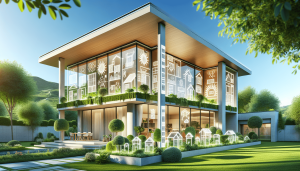We’re excited to dive into the social benefits of sustainable architecture. This fascinating field doesn’t just focus on creating eco-friendly buildings; it also emphasizes making a positive impact on our communities. Sustainable architecture paves the way for healthier living environments, promotes social equity, and fosters stronger, more connected neighborhoods. Together, let’s explore how the principles of sustainability can contribute to a better quality of life for all of us. Have you ever wondered about the impact of sustainable architecture on our communities and society as a whole? When we think about sustainable architecture, the first things that usually come to mind are eco-friendly materials, energy-efficient buildings, and reduced carbon footprints. But how often do we consider the broader social benefits that sustainable architecture brings?
What Are The Social Benefits Of Sustainable Architecture?
Sustainable architecture isn’t just about saving the environment; it’s also about fostering healthier, more sustainable communities. In this article, we’ll explore how this innovative form of design improves our social well-being. Let’s dive into this fascinating subject together.
Building Stronger Communities
Sustainable architecture encourages community integration. By designing public spaces that are both functional and inviting, we can create areas where people can come together. From parks and community centers to transit-oriented developments, these spaces foster a sense of belonging and improve social cohesion.
Enhancing Public Health
The quality of our built environment greatly affects our health. Sustainable architecture promotes the use of non-toxic materials, ample natural lighting, and efficient waste management systems. These elements contribute to healthier living and working environments, which can lead to a reduction in health issues such as respiratory problems and stress-related illnesses.
Improved Air Quality
Natural ventilation and air purification systems help in reducing indoor pollutants.
| Material | Use |
|---|---|
| Low-VOC paints | Reduce indoor air pollutants |
| Natural insulations | Minimize chemical exposure |
Increased Physical Activity
Designing walkable communities with easy access to biking and walking paths encourages residents to lead more active lifestyles. More physical activity not only leads to better physical health but also enhances mental well-being.

Educational Opportunities
Sustainable buildings can serve as educational tools. Schools and universities designed with sustainability in mind often incorporate educational features that teach students and the community about renewable energy, water conservation, and sustainable practices.
Environmental Stewardship Programs
Many sustainable buildings include programs aimed at educating the public on sustainable living.
| Program Type | Example |
|---|---|
| Workshops | Renewable energy |
| Seminars | Water conservation |
Economic Benefits
Though the upfront costs can be higher, sustainable architecture can result in long-term economic benefits. These savings can then be reinvested in the community, potentially funding social programs and services.
Lower Energy Costs
Energy-efficient buildings reduce utility bills, leaving more disposable income for residents and businesses.
| Expense Type | Conventional Building | Sustainable Building |
|---|---|---|
| Energy Bills | Higher | Lower |
| Maintenance Costs | Higher | Lower |

Job Creation
The shift toward sustainable architecture has created jobs in green construction, renewable energy, and environmental consulting. These jobs not only provide employment opportunities but also encourage skill development within communities.
Social Equity
Sustainable architecture has the potential to address social inequities. By focusing on affordability and access, it brings high-quality, well-designed buildings to underserved communities.
Affordable Housing
Sustainable building techniques can be used to create affordable housing that is both comfortable and cost-effective.
| Housing Type | Benefit |
|---|---|
| Affordable | Lower energy costs |
| Public | Improved living conditions |
Access to Amenities
Sustainable neighborhoods are often designed to be inclusive, ensuring that all residents have access to essential amenities, such as grocery stores, schools, and healthcare facilities.

Psychological Benefits
The design elements in sustainable architecture can have profound effects on our mental health. Natural lighting, green spaces, and aesthetically pleasing environments help in reducing stress and improving overall happiness.
Connection to Nature
Incorporating elements like green roofs and vertical gardens can create a strong connection to nature, offering a sense of peace and tranquility.
Stress Reduction
Access to natural light and open spaces has been shown to lower stress levels.
| Design Element | Benefit |
|---|---|
| Natural light | Reduces stress |
| Green spaces | Enhances mental well-being |
Cultural Enrichment
Sustainable architecture can promote cultural enrichment by preserving historical buildings and integrating local cultural elements into new projects. This strengthens community identity and pride.
Preservation of Heritage
Renovating old buildings using sustainable methods helps to preserve cultural heritage while upgrading them to modern standards.
| Building Type | Strategy |
|---|---|
| Historical | Sustainable renovation |
| Contemporary | Cultural integration |
Integration of Art
Public spaces in sustainable buildings often include art installations and cultural exhibits, making these areas more enjoyable and enlightening.
Climate Resilience
Sustainable architecture also makes communities more resilient to climate change. By designing buildings that can withstand extreme weather conditions, we ensure that our communities are safer and more prepared for the future.
Adaptive Reuse
Reusing existing structures reduces waste and preserves natural resources while offering new, sustainable spaces for community use.
| Building Type | Strategy |
|---|---|
| Old factories | Converted to lofts |
| Warehouses | Turned into community centers |
Disaster Preparedness
Sustainable buildings are often designed with disaster preparedness in mind, featuring elements like rainwater harvesting systems and solar panels.
Conclusion
As we can see, the social benefits of sustainable architecture are vast and far-reaching. By designing buildings and communities that prioritize not just the environment but also the well-being of the people who live in them, we can create a more equitable, healthy, and vibrant world for all. Together, let’s embrace sustainable architecture and the numerous advantages it brings to our society.



